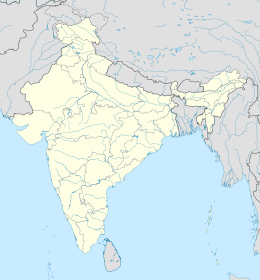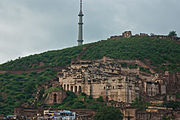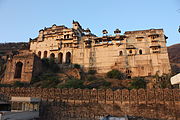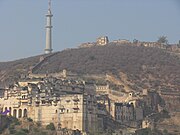Conquest of Hadoti
| Conquest of Hadoti | |||||||||
|---|---|---|---|---|---|---|---|---|---|
| Part of Mewar-Malwa Conflict | |||||||||
 | |||||||||
| |||||||||
| Belligerents | |||||||||
| Malwa Sultanate |
Mewar Kingdom Hadas of Bundi | ||||||||
| Commanders and leaders | |||||||||
| Mahmud Khalji |
Bairisal † Amar Singh (POW) Samar Singh (POW) | ||||||||
Location within Rajasthan | |||||||||
The Conquest of Hadoti was a significant military expedition led by Sultan Mahmud Khalji of Malwa against Hadoti. The primary objective of this campaign was to capture Bundi, Kota and Jhalawar, which were under the command of Bairisal, a subordinate of Rana Kumbha. Mahmud Khalji marched towards Hadoti in the year 1457-1458 A.D. to achieve this goal.
This time, he personally surveyed all the hillocks surrounding the fort and selected the western hillock as the base for his operations. The Hadoti is located in the south-eastern part of Rajasthan, India. During the year 1456-57 A.D, Hadoti was under the vassalage of Rana Kumbha.
Background[edit]
After conquering Gagron Fort, Mahmud Khilji sent his son Ghiyas Shah to subjugate Hadauti. However, the subjugation of Hadauti in 1444 A.D. did not firmly establish his authority as the Hadas, a freedom-loving Chauhan clan, would revolt whenever they had the opportunity. It is likely that Mahmud Khilji was apprehensive of the Hadas joining forces with Maharana Kumbha during the ongoing conflict between Malwa and Mewar. To keep the Hadas under pressure, he would send expeditions into the region from time to time.[4]
The conquest[edit]
A fierce battle erupted when Mahmud Khalji led his army against Hadoti, where Bairisal Hada, a Chauhan by lineage, held control over Bundi, Kota, and the entire Hadoti region. Despite Bairisal's best efforts to resist, Mahmud Khalji emerged victorious, ultimately defeating Bairisal in battle and conquering Bundi. Tragically, Bairisal lost his life while valiantly fighting against Mahmud Khalji.[1][2][3]
Raja of Kota paid Mahmud Khilji a tribute of one hundred and twenty-five thousand tankas. Historians do not mention the motive behind Mahmud Khilji's decision to advance against Kotah. After consulting his advisors, Mahmud Khalji decided to remove Rai Sanda from power in Kota. Without offering any resistance, Rai Sanda presented a tribute of one hundred and twenty-five thousand tankas to Mahmud Khalji.[5]
Aftermath[edit]
Following the battle, the two sons of Bairisal Hada, known as Amar Singh and Samar Singh, were captured and taken as prisoners to Mandu. It is reported that they embraced Islam and adopted the names Samarkandi and Umarkandi. It was a significant military conquest by Mahmud Khalji of the Malwa Sultanate in the region of Rajputana.[6] Rao Bhando(1459 -1503) son and successor of Rao Bairisal recaptured Bundi soon after.[7]
See also[edit]
References[edit]
- ^ a b Day, Upendra Nath (1978). Mewar Under Maharana Kumbha, 1433 A.D.-1468 A.D. Rajesh Publications.
- ^ a b Mathur, R. S. (1985). Relations of Hadas with Mughal Emperors, 1568-1720 A.D. Deputy Publications. pp. 29–30.
- ^ a b SAXENA, DR ARVIND KUMAR; PRADHAN, DR NEHA (2023-12-23). BUNDI : A Historical Odyssey. kitab writing publication. p. 36. ISBN 978-93-5868-526-8.
- ^ Sharma, Dasharatha (1990). Rajasthan Through the Ages: From 1300 to 1761 A.D. Rajasthan State Archives. p. 94.
- ^ Day, Upendra Nath (1965). Medieval Malwa: A Political and Cultural History, 1401-1562. Munshi Ram Manohar Lal. p. 27. ISBN 978-81-215-0401-0.
- ^ Hooja, Rima (2006). A History of Rajasthan. Rupa & Company. p. 363. ISBN 978-81-291-0890-6.
- ^ Hooja, Rima (2006). A History of Rajasthan. Rupa and Co. pp. 363 "Rao Bhando(1459-1503) eventually retook Bundi. Bhando is remembered not just for attempting to bring back order to the broken Kingdom, but also for distributing free grain to many famine-stricken areas during the severe famine of VS 1542(1486 AD)".







